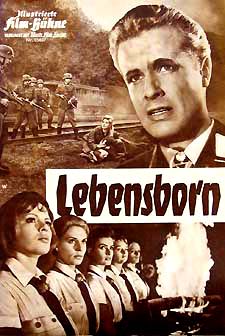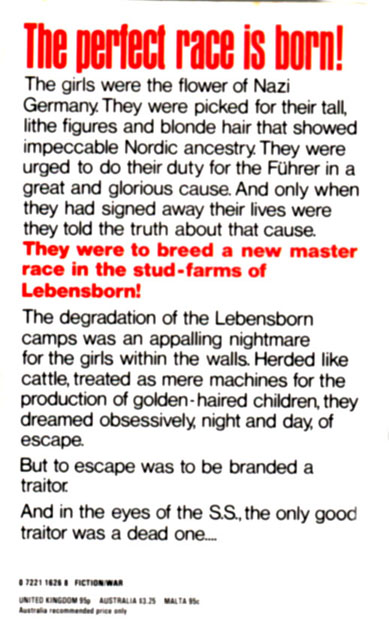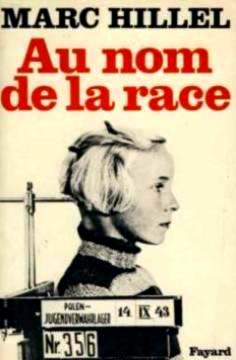
Excerpts from “Deutsche Mutter, bist du bereit” ["German Mother, Are You Prepared?"] by Dorothee Schmitz-Köster.
Translated by C. Porter

[Amazon blurb]
--
"Deutsche Mutter, bist du bereit ...": Die Kinder aus dem Lebensborn [GERMAN MOTHER: ARE YOU PREPARED..“ THE LEBENSBORN CHILDREN] by Dorothee Schmitz-Köster
"This book is a treasure trove for all those who are unsatisified by both cliché-ridden illusions and unemotional inspections of records and files relating to the Lebensborn, but who also wish to confront the present-day consequences of the monstrous attitudes of National Socialist Germany." (Der Tagesspiegel)
"The author allows the women concerned to speak for themselves – women who, until now, were hardly ever permitted to express themselves, in any other publication on the Lebensborn. These women provide a haunting picture of everyday life in the Lebensborn and National Socialist racial policy in Germany." (TAZ)
The Lebensborn Myth. Using a single Lebensborn home as an example, Dorothee Schmitz-Köster confronts the working methodologies, ideology and daily life of the SS Organisation – and faces up to the myth of the „National Socialist breeding establishments“. The author describes the women who gave birth in the Lebensborn or who worked there. And she describes the children who were born there: illegitimate children whose fathers‘ identities were concealed; "Norwegian Children", who were brought, first to Germany, and then, after the war, to Sweden; Lebensborn children who grew up in the DDR. Their biographies show the manner in which the Lebensborn has produced effects extending right down to the present day. Many of these children have conducted long research procedures in attempts to discover the identity of their fathers, where they were born, and what happened to them [book not available in English; amazon book blub translated by C.W. Porter]
--
Excerpt from Chapter 1
Taboo Areas and Freudian Projection
“A terrifying topic”, remarked a colleague, with a shudder, when I told her about my work on the Lebensborn. But then, very quickly and with great curiosity, she asked: “Was it really like that?”
What did she mean – like that? “That selected women and men were put together to engender children?”
I almost always met with this ambivalent reaction whenever I talk to anyone about the Lebensborn. Reluctance, defensiveness, sometimes even horror – that was one side of the reaction. The Lebensborn, as almost everyone knew, was closely linked to the “Black Order” of the SS, guilty of numerous crimes in the name of the Race; this is sufficiently well-known even without the pseudo-excuse [of pre-programmed procreation in Nazi “stud farms”] . But this feeling of reluctance, defensiveness and horror is also intermingled with curiosity in a highly unusual way, along with a pinch of craving for sensationalism and even a certain fascination.
Certainly, the attraction of the subject is due to the aura of mystery which surrounding the Lebensborn [and all its doings] from the very start. After all, the Lebensborn was founded in 1935 to offer women a place where
Page 14]
they could have their children under cover of secrecy. Upon request, the identity and very existence of the father was kept secret as well. The mothers were also permitted to give the child up for adoption, without the outside world being any the wiser -- no relatives, no registry office officials, no youth authority and no guardianship authority.
But the aura of mystery surrounding the Lebensborn extended far beyond the mere official items on its agenda. The Lebensborn concealed not only the pregnancy, birth and whereabouts of the child, but the identity of the father as well. There were widespread rumours and speculation about the origins of the Lebensborn children, even under the Third Reich.
Finally, they were considered “Aryan” through and through, and their parents were sought out according to the “strict hereditary biological selection principle” of the SS, as one information brochure declared (1). Did this indicate that the SS also played a role in the procreation of these children? Did not Heinrich Himmler, Reichführer SS and leading sponsor of the Lebensborn, personally encourage “SS men and German women and girls of good blood” to engender children, without regard to custom and morals, but merely “in belief in the Führer and in the will to the eternal life of our blood”? (2)
It simply had to be like that: The Lebensborn homes simply had to be luxury bordellos, in which “SS studs” – an expression which was current even while the National Socialists were still in power -- were paired off with selected girls and women to generate progeny for the “Aryan Elite”.
That no such practice ever occurred in the Lebensborn homes was proven long ago. Why is this persistent idea nevertheless still so attractive that it haunts peoples’ minds and provokes a morbid curiosity, even today? The linkage of Power with Innocence, personified in the image of black-uniformed SS men and blonde maidens, in which the emphasis, naturally enough, is on the girls, attesting to the girlish naiveté of the women participants. Is it some primaeval association with “Beauty and the Beast”? An allegory depicting the German people dominated by “fascism”? A repressed association between “sex and crime”?
Perhaps there is also the notion that the desire for a perfect child, the feasibility of which is now drawing closer, has a precursor in this regard – a precursor providing examples of abuse as well as promise.
The image of black-uniformed men coupling with blonde maidens to produce tailor-made “Aryan progeny” in luxurious bordellos is, in any event, still alive and kicking even today, surviving with astonishing tenacity. I’ve repeatedly found that both men and women cling to this preconceived notion with great vehemence and flatly refuse to abandon it. At the same time, their sources of information -- and the basis for their arguments -- is often quite limited: a novel they read years ago, an old movie, a history book that dealt with the Lebensborn in half a page. Or a rumour repeated by their parents or grandparents...
Articles, books, films...
A first glance at German language publications shows that very little has been published on the Lebensborn – that which has been published has been the products of entertainment literature: the works of authentic journalism and scholarship can be counted on ten fingers.
Historical researchers opened the debate in 1947-48, when four members of the Lebensborn Executive Board (3) were tried by a Nuremberg Tribunal on charges of “Crimes against Humanity”, “War Crimes” and, with the exception of Inge Viermetz, “Membership in a Criminal Organisation”,
Page 16]
i.e., membership in the SS. In the last point the three men were found guilty, but were acquitted on the others, because the judge considered the Lebensborn a charitable organisation (4).
The second series of news stories exploded in 1950, when the same members of the Lebensborn Executive Board were cited before the Main De-Nazification Court of Munich. This time, however, Lebensborn officials Gregor Ebner and Max Sollman were found guilty and sentenced to a few weeks forced labour, fines and loss of civil rights. The Lebensborn then returned to the headlines once again in 1955, when the German Bundestag took up an interest in the organisation.
On this occasion, Bundestag representatives and other government officials, after much discussion, decided to leave illegitimate Lebensborn children with their foster or adoptive parents unless their physical parents were found.
Three years later, in 1958, the journalist Will Berthold published a series of articles on the organisation in the “Illustrierte Revue”, at that time, still a serious magazine. A film, based on the book and also entitled “Lebensborn”, appeared in German cinemas in early 1961, produced by [Polish Jewish] film producer Artur Brauner.

[Trash film produced in 3 weeks by Polish Jew]
The film raised a storm of protest, particularly from the HIAG (Hilfsgemeinschaft auf Gegenseitigkeit), an organisation of former Waffen SS members. Film showings were Presentations under police protection, demanded by cinema owners, demolished showcases and the cancellation of showings, letters from the public, and accusations for defamation and libel were the result. Today such reactions would be interpreted as indications of success, but at the time they were a scandal.
The film shows a dramatic love story based on the folly of the Lebensborn, in which the participants fall into a trap more or less unconsciously: the enthustiastic BDM-girls and soldiers and SS men, assigned to a “biological apprenticeship course”. The girls know of course, that they are to
Page 17]
“give the Führer a child” but they do not know that they are to be coupled with a man for this purpose, a man selected by a “racial specialist”.
When it all becomes clear, there is resistance. One girl kills herself; hero and heroine however, in the meantime having become lovers, flee from the Lebensborn home, in which they are to procreate a child. But they are unable to escape from the organisation; the man is shot by the SS in attempting to escape, the woman is imprisoned and only escapes execution because the war is just about over. Her child, born in prison and immediately sent to a Lebensborn home, is never seen again. No happy ending, despite the well-known pattern, decorated and spiced up in the image of controlled breeding planned down to the last detail.
In 1975, a few more publications reached the market at the same time: forty years after the founding of the Lebensborn, ten years after the collapse of the NS regime. A Munich publishing house published two studies (5), otherwise an extensive non-fiction book and a TV documentary.
And once again Will Berthold was on the spot. This time with a “fact-based” novel, as promised by the subtitle; perhaps for this reason the book is sometimes quoted as a “source” to this day. In actual fact, Berthold delivers a piece of entertainment literature, with a catchy mixture of trivial love story and war novel. Here as well, the Lebensborn is depicted as an organisation which brings men and girls together for the procreation of Aryan offspring. This time, the voluntary women participants are even more unconscious of what they are in for than they are in the film. They only know that they are expected to make a sacrifice for the Führer and are eager to do so.


[Typical trash novel, all lies]
---
The two main characters in the book, already lovers before becoming involved with the Lebensborn,
Page 18]
suffer a particularly hard fate. As soon as they understand what it is all about, they attempt to escape from the organisation, but in so doing fall in the clutches of an evil SS leader, who treacherously robs them of their child. In compensation the author provides a personal conclusion: the two main characters find their child again after the war, and the Polish boy whom they have unknowingly brought up as their son returns to his physical mother.
To this melodramatic story the investigation of Marc Hillel and Clarissa Henry forms a striking counterweight (6).

[Attempts to "prove" existence of "Nazi breeding program" based on 4 or 5 convenience addresses used by unmarried mothers while confined in Lebensborn maternity homes elsewhere. In reality, these were the residential addresses of Lebensborn officials or even Lebensborn administrative offices. ]
---
Thirty years after the collapse of the organisation the two French journalists brought a book onto the French book market based on documents and testimonies of witnesses.
Among other things, Hillel and Henry located the former Lebensborn officials Inge Viermetz, Max Sollman and Gregor Ebner and spoke to them. The result was scanty: the three maintained that they merely helped women in a desperate situation, and appealed over and over again upon the judgement of the Nuremberg tribunal, which had evaluated the Lebensborn as a charitable organisation.
Despite this Hillel and Henry were able to sign the first extensive picture of the history and policies of the Lebensborn. They were also the first one to occupy themselves with the foreign activities of the Lebensborn: the founding of homes in Norway, France, Belgium and Luxembourg on the one hand , the “Germanisation actions” in the occupied territories of the East. There under the aegis of “Germanic racial policy”, Polish, Czech and Slovenian children of “good blood” were violently torn away from their social connections, interned by force, “re-educated” and finally taken to Germany, to Lebensborn homes, among other destinations.
On another point Hillel and Henry had in common with the authors of older publications. The two
Page 19]
French journalists obviously had an image in their minds when they began their research: the image of the black-uniformed SS men with blonde girls producing “Aryan” progeny in the Lebensborn homes. The authors attempt to prove the reality of this image by re-interpreting the term “sister” [i.e., nurse], turning not exactly unambiguous witnesses into key witnesses, by discovering assumed crime scenes everywhere they look. In so doing, they merely recounted the image of the Lebensborn, conveyed by means of rumours, the entertainment industry and the press for years.
It was ten more years before the publication of the first detailed scholarly study of the Lebensborn (7). At the end of the 1970s, the historian Georg Lilienthal began to research the archives of the International Tracing Service in Arolsen, the Bundesarchiv Koblenz, the Berlin Document Centre and the Archives of the German Foreign Office and found extensive amounts of documentation. A stroke of luck, as is clear today. The Archives of the International Tracing Service which possesses fifty folders of documents from the Lebensborn central office, is no longer -- temporarily – available to scholars and journalists.
On the basis of his discovery, Lilienthal was able to provide a very exact description of the history and policies of the Lebensborn. At the same time, he was able to prove that the organisation was in no way a charitable institution. Rather, it was an “instrument of National Socialist racial policy” and was intended to bring about a “selection and collection of Aryan blood”. And he was able to prove something else again too: rumours of planned procreation in the Lebensborn homes were current even while the National Socialists were still in power, but that there was no proof of any such practice, not even a mention. Himmler and other officials had, of course, according to Lilienthal, thought of such a practice, but “due to fear of negative reactions by public opinion” had given them up and postponed them until the time after the war (8). His investigations thus contradict the
Page 20]
rumours and speculation of “controlled procreation” which had circulated for decades.
As I myself studied the Lebensborn archives available today -- many dusty document folders and even more numerous microfiche documents – I found repeated confirmation of Georg Lilienthal’s findings. Statistics, minutes of meetings, informational brochures, orders, exchanges of correspondence, “racial expert reports”, etc., offer huge quantities of highly detailed information, ranging from political indoctrination to menus, from complaints to higher-ranking nurses right down to instructions for the conduct of the SS baptismal ceremony. There are no references, and there is no proof, of any “controlled reproduction” [i.e., the so-called “Nazi stud farms”].
While I was conducting this research, it became clear to me that the documentary situation is not without problems. There are, despite the quantity of material, many gaps, because at the war’s end part of the documentation was destroyed. Lebensborn employees were anxious to cover their traces and [sometimes] burnt documents for days on end -- for example, at Steinhöring -- the last headquarters of the central Lebensborn administration. But neighbours and Nazi-sympathizing bureaucrats [also] destroyed documentation, while the approaching occupation troops handled the documentation with anything but due care [an oblique reference to the fact that the Americans destroyed even more documents that the Germans, perhaps because 5 million Reichssmarks in cash also allegedly disappeared at the same time. – C.P]. References in the existing archive documentation and individual documents allow tentative conclusions to be drawn as to what was destroyed: thus, perhaps the central documentation as to the identities of the fathers, the “reports of racial experts” on the mothers and documentation on the foster homes and adoptive families. There is no indication of any missing documentation relating to “controlled reproduction”. Since the Lebensborn -- like all Nazi organisations -- possessed a highly developed bureaucracy, one may safely assume that such documentation did not exist.
---
Notes
1. Bundesarchiv NSD 41/103, p. 7.
2. SS order to all SS and Police (28.10.1939); to all men of the SS and Police (30.1.1940). In: Josef Ackermann: Heinrich Himmler als Ideologue, Faksimile 1, und Bundesarchiv NS 2/276.
3. The defendants included Gregor Ebner (head physician), Max Sollmann (President since 1940), Günther Tesch (Head of the Legal Department) and Inge Viermetz (Head of Main Department A 1941/42).
4. In Trial 8, the Nuremberg Court concerned itself, in particular, with the kidnapping of children from Eastern Europe, and investigated the extent to which the Lebensborn was involved in it. The judgement states as follows: “It is quite clear from the evidence that the Lebensborn Society, which existed long prior to the war, was a welfare institution, and primarily a maternity home... of the numerous organisations operating in Germany who were connected with foreign children brought into Germany, Lebensborn was the one organisation which did everything in its power to provide for the children and protect the legal interests of the children placed in its care”. The RuSHA-Case, vo. V, p. 162 f.
3. Will Berthold: Der Lebensborn e.V., and Hans Helmut Kirst: Die Nächte der langen Messer.
6. Marc Hillel/Clarissa Henry: Lebensborn e.V. Im Namen der Rasse. Hillel and Henry produced the film: „... dem Führer ein Kind schenken“, broadcast on German television in 1975.
7. Georg Lilienthal: Der „Lebensborn e.V.“/ Ein Instrument nationalsozialistischen Rassenpolitik (1985); revised and expanded 1993.
8. Lilienthal 1993, p. 162.
---
Excerpt 2
Page 132-133
The nurse Helga S. Recalled a “party with dancing and gifts. I left early, because I didn’t want to participate in the further events”. That the party was attended by mothers, personnel, godfathers and a guest “SS Sturm” from Bremen, Helga S is certain (129). But she was unable to recall anything else.
Is this an indication of any “controlled procreation”? How far did such parties go? How many couples might have met there? How many of these couples might have finally ended up in bed? Was this calculated and deliberate? Questions and speculations which arise through the description of Helga S. The young nurse in any case did not experience the further progress of the “party”. She only describes a feeling, an impression, a fear, that caused her to decline to participate. And my other interlocutors did not express themselves on this point: they couldn’t remember any such party: many only dimly remembered the naming ceremony.
Let us assume the party got boisterous, it ended up with people pairing off, a few of them landed in bed, and that they did so voluntarily. Up to this point, this is quite a normal occurrence – is this the “controlled breeding” to which the mystification of the entire association owes its origin? When we consider that most of the mothers left before the party even started -- because they had to breast-feed their babies and were therefore practically immune from conception anyway -- then the “party” could only have been intended for the female Lebensborn employees, since they were the only “receptive objects” available. But did they require such a big set up? Didn’t they constantly meet men anyway, in and around the home? Didn’t both offer enough opportunity to find a partner, for bed or for love, for the creation of children or for marriage?
[COMMENT: The above is followed by an anecdote of a Lebensborn employee who met her husband while ordering a coal delivery from the Army.
Are Army coal deliveries a "breeding program" in disguise? What exactly is a "breeding program"?
At this rate, any situation in which men and women are enabled to meet each other can be called a "breeding program", chess clubs, university, etc..
Maybe the whole coal industry is a "breeding program", the Army too... C.P.]
---
Excerpt 3
Page 247
One month later, in June 1945, the war photographer Robert Capa came to Hohehorst on assignment from LIFE, an American illustrated magazine, to photograph the “Norwegian children” -- which he obviously did with profound contempt. The photo essay published in August 1945 shows sulky blonde infants peering distrustfully into the camera, with a short text which spoke of “Nazi bastards” “grown pig fat” from too much oat meal, and sun and care, from “Nazi nurses”.
[COMMENT: Robert "Capa" was a Hungarian Jew who pretended to be some kind of American "expatriate" and is chiefly famous for a number of faked photographs taken during the Spanish Civil War.
To achieve instant fame, he even stole his name from Robert Capra, an Italian-American photographer and film maker who was already famous.
His photo fakery has been extensively proven in a detailed recent book, available only in Spanish, called SOMBRAS DE LA FOTOGRAFÍA by José Manuel Susperregui Etchebeste; but the information is widely available.
I will translate some excerpts from this exposé of yet another fantastic faker. - C.P.]

--
LINKS:
Excerpt from introduction to "Der Lebensborn, e.V,", by Georg Lilienthal (translated by C.W. Porter) click here
Excerpts from pp 150-155 of "Der Lebensborn, e.V,", by Georg Lilienthal (translated by C.W. Porter) click here
Excerpts from “Deutsche Mutter, bist du bereit” ["German Mother, Are You Prepared?"] by Dorothee Schmitz-Köster (translated by C.W. Porter) click here
Excerpt from Chapter 1 of “Dem Führer ein Kind Schenken” by Volker Koop (translated by C.W. Porter) click here
Excerpt from pp. 232-34 of “Dem Führer ein Kind Schenken” by Volker Koop (translated by C.W. Porter) click here
Excerpts from "Master Race: The Lebensborn Experiment in Germany" by Catherine Clay and Michael Leapman -- click here
"Master-Race"/Lebensborn Internet World Lie Championships FIRST PRIZE -- I Am a Lebensborn Child -- click here
"Master-Race"/Lebensborn Internet World Lie Championships SECOND PRIZE -- "Master Race Baby" Olaf Schmedermann -- click here
"Master-Race"/Lebensborn books on amazon.com, amazon.de and amazon.fr (with translations) click here
"Master-Race"/Lebensborn World Championship Lie Videos on youtube.com (with translations) click here
Review of History Channel's "History's Mysteries: The Lebensborn (reviewed by C.W. Porter) click here
Filmography of Arthur Brauner, "German" producer of world's first "terrifying" trash film epic about "Nazi sex farms" (completed in 3 weeks) -- click here
The Non-Existence of any Nazi "Doctrine" of the "Master Race" -- click here
The "Master Race" accusation at Nuremberg -- click here
Jewish Racism - click here
Excepts from "Myth of the Twentieth Century" -- Use of word "Herrenvolk" by Alfred Rosenberg -- click here
Use of word "Master Race" in standard literature -- click here
Anti-Nazi "Master Race" sexploitation pics -- click here
Nazi "Sex Farms" -- The Lie... and the Reality... click here
Explanation of remarks on William L. Shirer -- click here